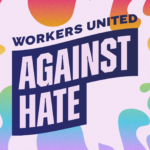
by CLC Executive Vice-President Marie Clarke Walker
In 1946, Halifax businesswoman Viola Desmond went to a movie and sat on the main floor. The staff asked her to move: as a Black woman she was only allowed to sit in the balcony. When she refused, she was hauled out of the theatre by police and held overnight in jail, without being advised of her rights.
The discrimination Desmond faced was only the tip of the iceberg. Black Canadians experienced explicit employment and housing discrimination, unequal treatment at restaurants, hotels, theatres and swimming pools. Black children (mainly in Ontario and Nova Scotia) were sometimes sent to segregated schools. The last segregated school in Canada closed in 1983.
Viola Desmond’s decision to resist that day, and to fight the charges brought against her, helped galvanize the Black community in Nova Scotia, and raise awareness of racism and segregation across Canada and internationally. Segregation legally ended in Nova Scotia in 1954, thanks to the courage of people like Viola Desmond.
In February we celebrate Black History Month, a time when we look at how far we have come. It’s true, we have made strides and, some would say, progress.
Black people are no longer relegated to special seats in theatres. Today, we are proud to celebrate Ms. Desmond’s courage, resistance and contribution by honouring her on our $10 bill.
As we celebrate Black History Month, we should also take time to evaluate and assess our way forward, which includes the work that still remains to be done in order to achieve a more inclusive and equitable society.
At this time in our history, the challenge can seem particularly daunting. Systemic racism is still a daily reality for Black Canadians. For example, just a few weeks ago Halifax police released statistics showing they are three times more likely to street check Black people than White people. Carding and racial profiling are practices seen right across the country and they are only two of many examples of anti-Black racism in our society.
So how can we move forward in our new reality? There is work that we can do as unions and individuals.
As unions, we need to ensure that human rights are front and centre in all the work we do. We should be using an equity lens when looking at all issues.
We have long known that racial and economic justice are fundamentally connected, and we can better integrate that analysis in our work.
We also have to keep educating our members on the reality of systemic racism and other forms of oppression. One thing we’re doing at the CLC for Black History Month is running a series of webinars called “Working While Black.” The series will celebrate the contributions of Black activists and organizers in Canada, strengthen solidarity across movements, and build skills and knowledge for confronting anti-Black racism in workplaces and communities today.
By taking these steps and articulating a vision for a fairer future, unions can find the common ground that can bring our members and communities together.
As individuals, if we want to move forward, we need to take care of ourselves and each other. Part of that can be reminding ourselves to look around and get inspired by those courageous individuals past, present, and future, who have dedicated themselves to building inclusive workplaces and communities. Let’s celebrate Black History Month by learning from their strategies, energy, and courage.



